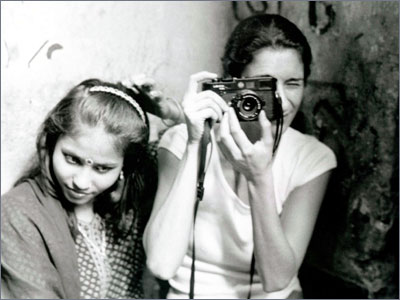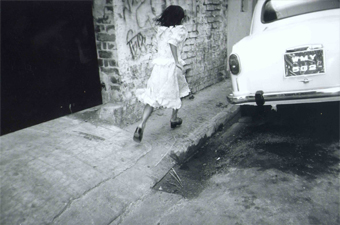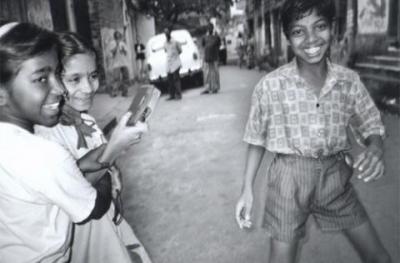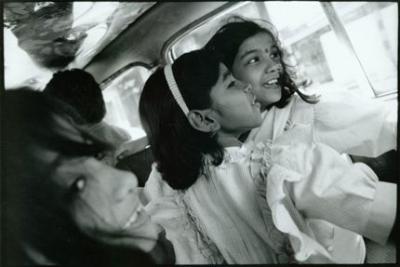Serendip is an independent site partnering with faculty at multiple colleges and universities around the world. Happy exploring!
Notes Towards Day 25: Feminist Documentary Film
Notes towards Day 25 of
Critical Feminist Studies
Feminist Documentary Film:
Born Into Brothels


II. Afterthoughts from Jessy's visit?
on audience/response:
relation between #s of readers & response-writers
ssherman: couldn't one make the argument that anything one posts online...is published?...we all feel a little vulnerable having everything on serendip available for anyone to see, but really even on facebook...
Ann Dixon: what you all do and write on Serendip...is a construct of your class and yourselves, not limited by Serendip's identity and range of published experiences.
III. Sarina and Emily--how to start discussion re: film?

B. Community of Practitioners
Documentary filmmakres share a common, self-chosen mandate to represent the historical world rather than to imaginatively invent alternative ones....The documentary tradition relies heavily on being able to convey to us the impression of authenticity...that what we see bears witness to the way the world is (25, xiii).
D. Constituency of Viewers
The sense that a film is a documentary lies in the mind of the beholder as much as it lies in the film's context or structure....Most fundamentally, we bring an assumption that the text's sounds and images have their origin in the historical world we share...not conceived and produced exclusively for the film (35).

V. Returning to the large group, to discuss the relationship between feminism and documentary cinema:
(From Annette Kuhn, "Passionate Detachment,"
Women's Pictures: Feminism and Cinema):
taken together, they might provide a basis for certain types of intervention in culture....
A feminine language would be more open, would set up multiplicities of meanings...making the moment of reading one in which meanings are set in play rather than consolidated or fixed....A feminine text has no fixed formal characteristics, precisely because it is a relationship...
Critical Feminist Studies
Feminist Documentary Film:
Born Into Brothels

I. Coursekeeping
Amanda, Sarina--final "naming"/knowing
Monday @ 9 a.m.:
third paper due, on-line and in hard copy w/ two others
Monday by noon:
post poem about women, men, gender, feminism,
the feminine, the masculine, sexism, sex....
Tuesday by classtime:
read all poems, come w/ a response to one
(to post before or after)
Thursday: final performances
(sign up now for your groups; also for final conferences)
As requested: here are instructions for
printing off all your forum comments:
Amanda, Sarina--final "naming"/knowing
Monday @ 9 a.m.:
third paper due, on-line and in hard copy w/ two others
Monday by noon:
post poem about women, men, gender, feminism,
the feminine, the masculine, sexism, sex....
Tuesday by classtime:
read all poems, come w/ a response to one
(to post before or after)
Thursday: final performances
(sign up now for your groups; also for final conferences)
As requested: here are instructions for
printing off all your forum comments:
log in, type
/exchange/mycomments
select "printer-friendly version" (@ top) and print!
course evals, today or Tuesday...
/exchange/mycomments
select "printer-friendly version" (@ top) and print!
course evals, today or Tuesday...

II. Afterthoughts from Jessy's visit?
on audience/response:
relation between #s of readers & response-writers
rfindlay: I am not one of those people who enjoys trying to catch all my thoughts
and explain them in person, but I would rather do it in person than in
any other way--the audience is too broad and unresponsive elsewhere....instead of using third person pronouns, why not make them all second person, and invite the person to respond?
ssherman: couldn't one make the argument that anything one posts online...is published?...we all feel a little vulnerable having everything on serendip available for anyone to see, but really even on facebook...
you are ...exposing yourself ...any form of writing,
be it im, texts, facebook, or email, are real forms of writing.
Ann Dixon: what you all do and write on Serendip...is a construct of your class and yourselves, not limited by Serendip's identity and range of published experiences.
III. Sarina and Emily--how to start discussion re: film?
IV. Small group work:
First tell one another what your reactions/questions are.
Then discuss (all quotes from Bill Nichols,
Introduction to Documentary, Indiana, 2001):
A. Institutional Framework
"To remind viewers of the construction of the reality we behold, of the creative element in John Grierson's famous definition of documentary as "the creative treatment of actuality," undercuts the very claim to truth and authenticity on which the documentary depends....By suppressing this question, the institutional framework for documentary suppresses much of the complexity in the relationships between representation and reality, but it also achieves a clarity or simplicity that implies that documentaries achieve direct, truthful access to the real. This functions as one of the prime attractions of the form (24-25).
First tell one another what your reactions/questions are.
Then discuss (all quotes from Bill Nichols,
Introduction to Documentary, Indiana, 2001):
A. Institutional Framework
"To remind viewers of the construction of the reality we behold, of the creative element in John Grierson's famous definition of documentary as "the creative treatment of actuality," undercuts the very claim to truth and authenticity on which the documentary depends....By suppressing this question, the institutional framework for documentary suppresses much of the complexity in the relationships between representation and reality, but it also achieves a clarity or simplicity that implies that documentaries achieve direct, truthful access to the real. This functions as one of the prime attractions of the form (24-25).
B. Community of Practitioners
Documentary filmmakres share a common, self-chosen mandate to represent the historical world rather than to imaginatively invent alternative ones....The documentary tradition relies heavily on being able to convey to us the impression of authenticity...that what we see bears witness to the way the world is (25, xiii).
C. Corpus of Texts
Norms and conventions come into play for documentary that help distinguish it: the use of a voice-of-God commentary, interviews, location sound recordings, cutaways from a given scene to provide images that illustrate or complicate a point made within the scene, and a reliance on social actors, or people in their everyday roles and activities, as the central characters of the film are among those that are common....Another convention is the prevalanece of an informing logic that organizes the film....typical is that of problem solving (26).
Norms and conventions come into play for documentary that help distinguish it: the use of a voice-of-God commentary, interviews, location sound recordings, cutaways from a given scene to provide images that illustrate or complicate a point made within the scene, and a reliance on social actors, or people in their everyday roles and activities, as the central characters of the film are among those that are common....Another convention is the prevalanece of an informing logic that organizes the film....typical is that of problem solving (26).
D. Constituency of Viewers
The sense that a film is a documentary lies in the mind of the beholder as much as it lies in the film's context or structure....Most fundamentally, we bring an assumption that the text's sounds and images have their origin in the historical world we share...not conceived and produced exclusively for the film (35).
V. Returning to the large group, to discuss the relationship between feminism and documentary cinema:
(From Annette Kuhn, "Passionate Detachment,"
Women's Pictures: Feminism and Cinema):
taken together, they might provide a basis for certain types of intervention in culture....
A feminine language would be more open, would set up multiplicities of meanings...making the moment of reading one in which meanings are set in play rather than consolidated or fixed....A feminine text has no fixed formal characteristics, precisely because it is a relationship...
reception is crucial
....openness as a defining characteristic of the feminine is something very different from the closure...implied by the tendentious text....
a cultural practice calling itself feminist may actually be characterised by some degree of closure: a restricted range of possible readings."
....openness as a defining characteristic of the feminine is something very different from the closure...implied by the tendentious text....
a cultural practice calling itself feminist may actually be characterised by some degree of closure: a restricted range of possible readings."
(From Julia Lesage, "The Political Aesthetics of the Feminist Documentary Film." Issues in Feminist Film Criticism, ed. Patricia Erens):
Feminist documentary filmmaking is...congruent with...the affinity group...The films...came out of the same ethos as the consciousness-raising groups and had the same goals...deliberately used a traditional "reality" documentary structure...valorized their subjects' words...looked @ familiar elements to define them in a new, uncolonized way....The intent is political. Yet the films' very strength, the emphasis on the experiential, can sometimes be a political limitation, especially when the film...offers little or no analysis or sense of collective process leading to social change.
Feminist documentary filmmaking is...congruent with...the affinity group...The films...came out of the same ethos as the consciousness-raising groups and had the same goals...deliberately used a traditional "reality" documentary structure...valorized their subjects' words...looked @ familiar elements to define them in a new, uncolonized way....The intent is political. Yet the films' very strength, the emphasis on the experiential, can sometimes be a political limitation, especially when the film...offers little or no analysis or sense of collective process leading to social change.


